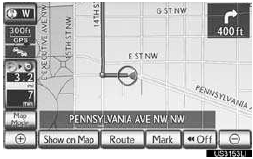GPS (Global positioning system)
LIMITATIONS OF THE NAVIGATION SYSTEM
This navigation system calculates the current position using satellite signals, various vehicle signals, map data, etc.
However, an accurate position may not be shown depending on satellite condi- tions, road configuration, vehicle condi- tion or other circumstances.
The Global Positioning System (GPS) de- veloped and operated by the U.S. Depart- ment of Defense provides an accurate current position, normally using 4 or more satellites, and in some case 3 satellites. The GPS system has a certain level of inaccura- cy. While the navigation system will com- pensate for this most of the time, occasional positioning errors of up to 300 ft. (100 m) can and should be expected. Generally, po- sition errors will be corrected within a few seconds.

When the vehicle is receiving signals from satellites, the ÔÇťGPSÔÇŁ mark appears at the top left of the screen.
The GPS signal may be physically obstruct- ed, leading to inaccurate vehicle position on the map screen. Tunnels, tall buildings, trucks, or even the placement of objects on the instrument panel may obstruct the GPS signals.
The GPS satellites may not send signals due to repairs or improvements being made to them.
Even when the navigation system is receiv- ing clear GPS signals, the vehicle position may not be shown accurately or inappropri- ate route guidance may occur in some cas- es.
NOTICE
● The installation of window tinting may obstruct the GPS signals. Most window tinting contains some metallic content that will interfere with GPS signal recep- tion of the antenna in the instrument panel. We advise against the use of win- dow tinting on vehicles equipped with navigation systems.
● Accurate current position may not be shown in the following cases:
ÔÇó When driving on a small angled Y-shaped
road.
ÔÇó When driving on a winding road.
ÔÇó When driving on a slippery road such as
in sand, gravel, snow, etc.
ÔÇó When driving on a long straight road.
ÔÇó When motorway and surface streets run
in parallel.
ÔÇó After moving by ferry or vehicle carrier.
ÔÇó When a long route is searched during
high speed driving.
ÔÇó When driving without setting the current
position calibration correctly.
ÔÇó After repeating a change of direction by
going forward and backward, or turning
on a turntable in a parking lot.
ÔÇó When leaving a covered parking lot or
parking garage.
ÔÇó When a roof carrier is installed.
ÔÇó When driving with tire chains installed.
ÔÇó When the tires are worn.
ÔÇó After replacing a tire or tires.
ÔÇó When using tires that are smaller or
larger than the factory specifications.
ÔÇó When the tire pressure in any of the 4
tires is not correct.
● If the vehicle cannot receive GPS signals, the current position can be adjusted manually. For information on setting the current position calibration.
● Inappropriate route guidance may occur in the following cases:
ÔÇó When turning at an intersection off the
designated route guidance.
ÔÇó If you set more than 1 destination but skip
any of them, auto reroute will display a
route returning to the destination on the
previous route.
ÔÇó When turning at an intersection for which
there is no route guidance.
ÔÇóWhen passing through an intersection for
which there is no route guidance.
ÔÇó During auto reroute, the route guidance
may not be available for the next turn to
the right or left.
ÔÇó During high speed driving, it may take a
long time for auto reroute to operate. In
auto reroute, a detour route may be
shown.
ÔÇó After auto reroute, the route may not be
changed.
ÔÇó If an unnecessary U-turn is shown or
announced.
ÔÇó If a location has multiple names and the
system announces 1 or more of them.
ÔÇóWhen a route cannot be searched.
ÔÇó If the route to your destination includes
gravel, unpaved roads or alleys, the route
guidance may not be shown.
ÔÇó Your destination point might be shown on
the opposite side of the street.
ÔÇó When a portion of the route has regula-
tions prohibiting the entry of the vehicle
that vary by time or season or other rea-
sons.
ÔÇó The road and map data stored in the navi-
gation system may not be complete or
may not be the latest version.
● After replacing a tire, implement the operation described in ÔÇťTIRE CHANGE CALIBRATIONÔÇŁ
INFORMATION
● This navigation system uses tire turning data and is designed to work with factory- specified tires for the vehicle. Installing tires that are larger or smaller than the originally equipped diameter may cause inaccurate display of the current position.
The tire pressure also affects the diame- ter of the tires, so make sure that the tire pressure of all 4 tires is correct.
See also:
Detour setting
While the route guidance is operating, you can change the route to detour around
a section of the route where a delay is caused by road repairs, or an accident,
etc.
1. Touch ÔÇťRouteÔÇŁ.
2. ...
Do-it-yourself maintenance
Do-it-yourself service precautions
If you perform maintenance by yourself, be sure to follow the correct
procedures
as given in these sections.
CAUTION:
The engine compartment contains many ...
Removing the luggage cover
The luggage cover can be removed by following the procedure below.
Retract the cover and release both ends, then lift it out.
Vehicles without third seats: After removing the luggage cover, place it ...
